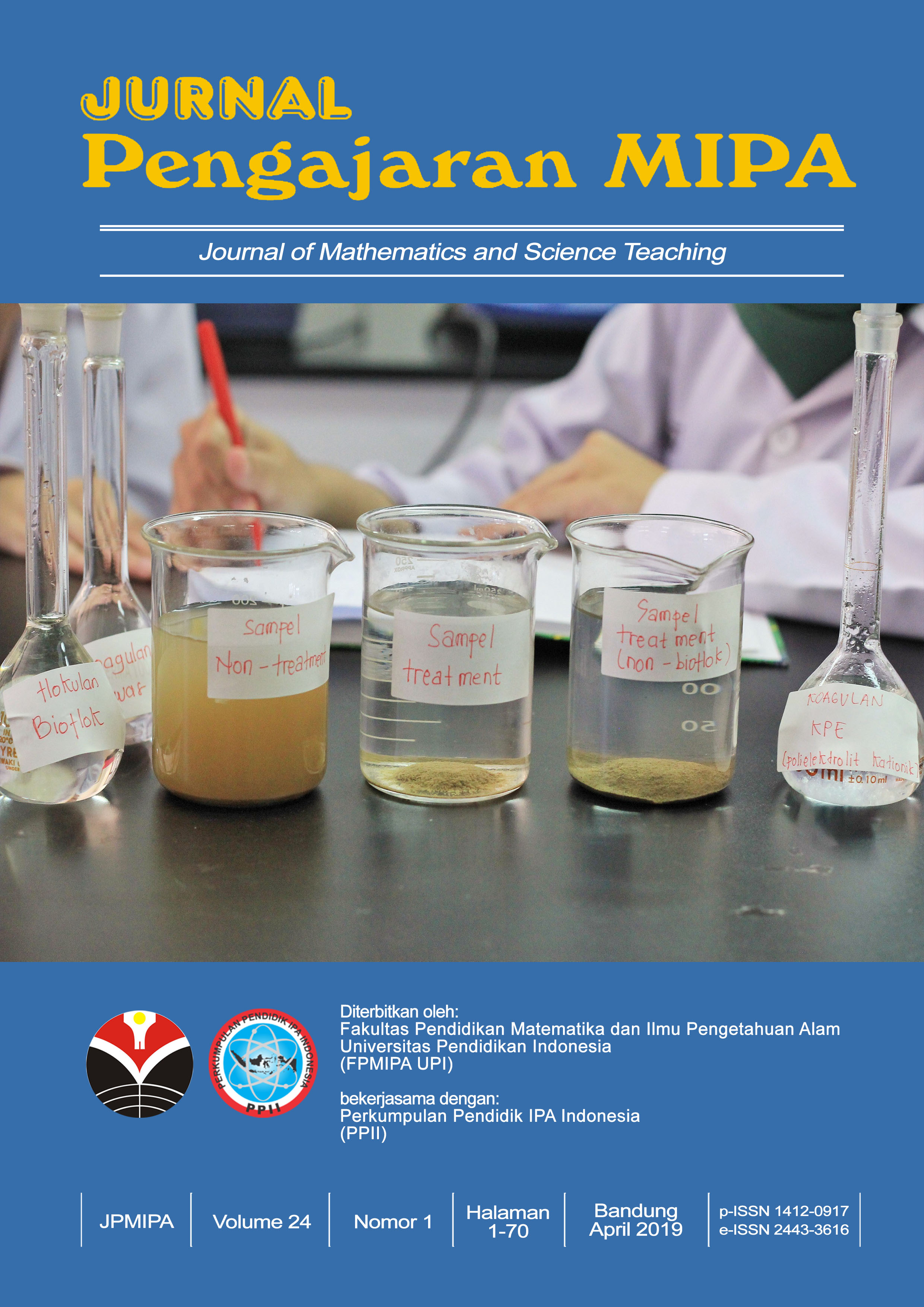THE ANALYSIS OF STUDENTS’ CRITICAL THINKING IN JUNIOR HIGH SCHOOL MEASURED BY SCIENCE VIRTUAL TEST (SVT)
Abstract
This descriptive research described a profile of students’ critical thinking that measured by Science Virtual Test (SVT). The participants who involved in this study are 563 students on Junior High School (JHS). Their distibution are 188 students in 7th grade (13 years old), 265 students in 8th grade (14 years old), and 110 students in 9th grade (15 years old). They comes from Bandung city, Bandung district, West Bandung district, Tasikmalaya city, and Kuningan city that gathered in West Java, Indonesia. Qualitatative data were obtained by using five packages of Scienve Virtual Test (SVT) with topic on integrated concepts “living things and environmental sustainability” and separated concepts “heat and matter; human digestive system”. Results showed that general achievement of students’ critical thinking was 58.24%. Its mean in ‘medium’ level. The highest score on element “interpretation and inference” (66.18%) while the lowest score on element “question at issue” (42.02%). Therefore, the strategy to improve of students’ critical thinking is needed.
Keywords
References
Blondy, L. C. (2007). Evaluation and Application of Andragogical Assumptions to The Adult Online Learning Environment. Journal of Interactive Online Learning Vol. 6, No. 2, pp. 116-130.
Chin, C. (2002). Student-Generated Questions: Encouraging Inquisitive Minds in Learning Science. Teaching and Learning Vol. 23, No. 1, pp. 59-67.
Chua, Y. P. and Don, Z. M. (2013). Effects of Computer-based Educational Achievement Test on Test Performance and Test Takers’ Motivation. Computers in Human Behavior Vol. 29, No. 1, pp. 1889–1895.
Creswell, J.W. (2012). Educational Research: Planning, Conducting, and Evaluating Quantitative and Qualitativee Research Fourth Edition. Boston: Pearson Education.
Deyglio, S. (2015). Engaging Critical Thinking Skills with Learners of The Special Populations. Educator’s Voice Vol. 8, No. 1, pp. 62-71.
Fraenkel, J.R. and Wallen, N.E. (2006). How to Design and Evaluate Research in Education Sixth Edition. New York: McGraw-Hill.
Gelerstein, D., del Rio, R., Nussbaum, M., Chiuminatto, P., and Lopez, X. (2016). Designing and Implementing A Test for Measuring Critical Thinking in Primary School. Thinking Skills and Creativity Vol. 20, No. 1, pp. 40–49.
Hamiloğlu, K. and Temiz, G. (2012). The Impact of Teacher Questions on Student Learning in EFL. Journal of Educational and Instructional Studies in The World Vol. 2, No. 2, pp. 1-8.
Inch, E. S., Warnick, B., and Endres, D. (2006). Critical Thinking and Communication: The Use of Reason in Argument Fifth Edition. United States of America: Pearson Education.
LaMartina, K. and Ward-Smith, P. (2014). Developing Critical Thinking Skills in Undergraduate Nursing Students: The Potential for Strategic Management Simulations. Journal of Nursing Education and Practice Vol. 4, No. 9, pp. 155-162.
Lloyd, M. and Bahr, N. (2010). Thinking Critically about Critical Thinking in Higher Education. International Journal for the Scholarship of Teaching and Learning Vol. 4, No. 2, pp. 1-16.
Mauigoa, L. and Tekene. (2006). Enhancing Teachers’ Questioning Skills to Improve Childrens’ Learning and Thinking in Pasific Island Early Childhood Centers. New Zealand Journal of Teachers’ Work Vol. 3, No. 1, pp. 12-23.
McMillan, J. H. and Schumacher, S. (2001). Research in Education: A Conceptual Introduction. New York: Addison Wesley Longman.
Piaw, C. Y. (2012). Replacing Paper-based Testing with Computer-based Testing in Assessment: Are We Doing Wrong? Procedia - Social and Behavioral Sciences Vol. 64, No. 1, pp. 655 – 664.
Rusyati, L. and Rustaman, N. (2013). Pengembangan Soal Pilihan ganda Berpikir Kritis Inch dan Profil Pencapaiannya di SMA Negeri Kota Bandung pada Tema Penyakit Manusia. Jurnal Pengajaran MIPA Vol. 18, No. 1, pp. 124-134.
Rusyati, L. and Firman, H. (2016). Science Virtual Test: A Computer-Based Test to Measure Students’ Critical Thinking on Living Things and Environmental Sustainability Theme. Advances in Social Science, Education and Humanities Research (ASSEHR) Vol. 57, No. 1, pp. 10-13.
Schmaltz, R. M., Jansen, E. and Wenckowski, N. (2017). Redefining Critical Thinking: Teaching Students to Think like Scientists. Frontiers in Psychology Vol. 8, No. 1, pp. 1-4.
Slisko, J. and Cruz, A. C. (2013). Helping Students to Recognize and Evaluate An Assumption in Quantitative Reasoning: A Basic Critical-Thinking Activity with Marbles and Electronic Balance. European Journal of Physics Education Vol. 4, No. 4, pp. 19-25.
DOI: https://doi.org/10.18269/jpmipa.v23i2.16867
Refbacks
- There are currently no refbacks.
Copyright (c) 2019 Jurnal Pengajaran MIPA

This work is licensed under a Creative Commons Attribution-ShareAlike 4.0 International License.
JPMIPA http://ejournal.upi.edu/index.php/jpmipa/index is licensed under a Creative Commons Attribution-ShareAlike 4.0 International License
Jurnal Pengajaran Matematika dan Ilmu Pengetahuan Alam (JPMIPA) or Journal of Mathematics and Science Teaching
All rights reserverd. pISSN 1412-0917 eISSN 2443-3616
Copyright © Faculty of Mathematics and Science Education (FPMIPA) Universitas Pendidikan Indonesia (UPI)
View JPMIPA Stats









